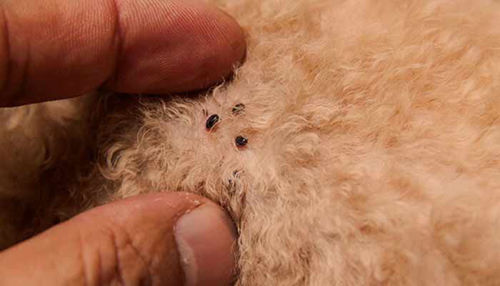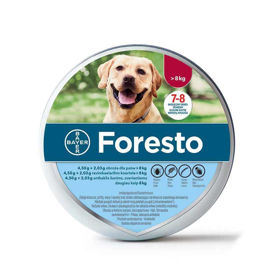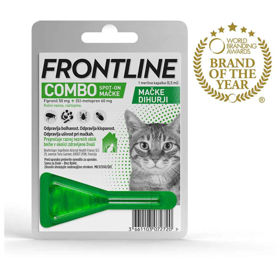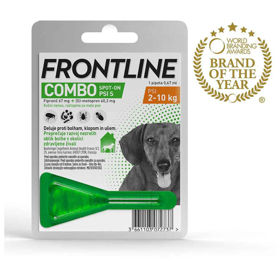Dog fleas or dog fleas are one of the types of fleas found in homes and got their common name because dogs are one of their favorite hosts. Some dogs can be hypersensitive to flea saliva and experience itching all over their body from a single flea bite.
FLEAS ON DOGS: Fleas on dogs in general | Symptoms | Diseases and Problems | Allergic dermatitis | Straps | Anemia | Bartonellosis | Effective protection | Flea Removal | Questions and Answers | Sources/references
Fleas are parasites that feed on blood. They cause discomfort due to irritating bites, but they can also transmit various stubborn diseases. Dogs'Unfortunately, the soft, warm fur provides the perfect environment for fleas - they are more common in the warmer months, but you can get rid of them at any time of the year by taking action.
Adult dog fleas are about 2.5 mm long, laterally flattened, and wingless. Their bodies are brownish-black to black, but they can appear reddish-black, especially when full of blood. Like cat fleas, dog fleas have disproportionately small heads and six legs; their hind legs are solid and can jump great distances.
Dogs often become infected with fleas through contact with other animals or contact with fleas in the environment. The strong hind legs allow this insect to jump from host to host or from its surroundings to its host.
Video content: Fleas in dogs in general

A flea bite can cause the host to itch, but itching can be highly uncomfortable for a sensitive animal or an animal allergic to fleas. In addition, it can cause severe scratching and chewing of the affected area, which causes hair loss, inflammation, and secondary skin infections.
Symptoms of fleas present
Here are some symptoms of flea bites in dogs to look out for:
- severe scratching and itching
- biting and chewing the skin
Video content: 6 symptoms related to the presence of fleas

- red and irritated skin
- loss of hair in a specific area
- scabs
Diseases and problems of the presence of fleas
There are many diseases and problems that fleas can carry.
Fleas and their bites can irritate your dog's skin, spread diseases and cause various health problems. For example, Flea saliva often causes severe allergic dermatitis in pets, and their residues are said to cause similar allergic reactions in humans.
Fleas can also transmit tapeworms and cause anemia in dogs in the long term, so active flea control is crucial.
Video content: can fleas transmit diseases?

Four common dog diseases and medical conditions:
- allergic dermatitis due to the presence of fleas
- tapeworms carried by fleas
- anemia
- bartonellosis
1. Allergic dermatitis due to fleas
Flea allergic dermatitis is the leading cause of allergic reactions in dogs. In an allergic reaction, the dog's immune system overreacts or is hypersensitive to a substance (antigen) that is usually harmless. Unfortunately, many dogs suffer from allergic dermatitis due to fleas, one of the most common reasons for visiting the vet.
Allergic dermatitis from fleas is a common cause of itching in dogs. When fleas feed, they inject a small amount of saliva into the skin. Antigens in saliva cause a strong itchy response in susceptible dogs. Even a single flea bite can cause itching that can last long days.
Video content: What is flea allergic dermatitis?

You may not notice fleas immediately, but you will see signs of an allergic reaction. When dogs feel flea bites, they often chew, bite their tails, and jump from a resting position. In addition, if your dog experiences itching that causes hair loss from the middle of the back to the base of the tail, this may indicate allergic dermatitis.
Hair loss can spread throughout the body if allergic dermatitis is not treated. When a dog scratches, licks, and chews, it breaks down the skin barrier, which in turn causes open wounds and scabs. In addition, licking and chewing can cause constant moisture, producing fungal and bacterial infections. If you suspect your dog has allergic dermatitis due to fleas, take him to the vet or react in time and put a protective insecticidal collar on your dog before the season.
Allergic dermatitis due to fleas
Allergic dermatitis caused by fleas causes the following symptoms:
- red skin
- missing areas of hair on fur
- repetitive scratching, rubbing, or biting of the skin
- warm skin or infected sores, usually on the legs, buttocks, and tail
2. Tapeworms
Dogs can ingest fleas while biting irritated skin from flea bites or while licking and grooming their fur. However, the dog can also become infected if these ingested fleas are infected with tapeworm. Once in the digestive system, tapeworms attach themselves to the intestinal mucosa with their sucking mouthparts.
If your dog is infected with tapeworm, you may notice pieces of worms around his anus. These pieces, which look like grains of white rice, are tapeworm eggs. If you look closely, you might even see them move. This is because when the outer shell of the eggs dries, the eggs are released into the environment where the cycle can repeat itself.
Video content: Flea-transmitted tapeworms in cats and dogs

Praziquantel is an anthelmintic drug often used to treat tapeworm infections. The drug is usually given in pill form but is also available as an injection and topical formulation. Monthly deworming will help prevent re-infection.
Tapeworms rarely cause severe symptoms in healthy dogs, but young, ancient dogs or dogs with weakened immune systems can show more severe symptoms, such as intestinal blockages. These can even be fatal if not treated.
Signs and symptoms of tapeworm presence
The signs and symptoms of tapeworm in dogs vary depending on the severity of the infection but often include the following:
- irritability
- the reduced appetite of the dog
- intestinal blockage
- mushy fur
- tapeworms in stool or vomiting
- canine anemia (tongue)
- diarrhea
3. Anemia
Puppies, older pets, and those who are sick and immunocompromised are prone to severe complications, including flea anemia. Heavy infestations result in significant blood loss, as fleas suck the blood of their hosts to survive.
It is, therefore, pointless to underestimate a pet's flea infestation, as a dog not allergic to flea bites will not scratch or lose hair. The owner may not realize that a heavy infestation may be active, especially if the pet is very efficient at licking and grooming.
Video content: Dr. Becker on anemias in dogs

A test to assess the degree of anemia called the Hematocrit (HCT) is accessible at the vet's office. Hematocrit reflects the percentage of red blood cells that should be present in a blood sample - in dogs, the normal range is 38 to 57 units. Therefore, blood transfusion is considered when the condition is alarming, and the values reach only 20 units or less.
Anemia due to fleas
The following symptoms may occur with anemia:
- lethargy
- poor tolerance of physical activity
- dark blood in stool or vomit
- bruises on the skin
- dark mud
- pale gums
4. Bartonellosis
Bartonellosis is a bacterial infection that dogs can acquire as a bloodstream infection. Fleas, ticks, lice, and sand flies transmit bartonellosis. It can cause fever and inflammation of many organs in the body, including the heart. Therefore, hunting and working dogs that encounter livestock and wild animals have a higher risk of contracting bartonellosis than dogs that spend most of their time indoors or in the city.
Symptoms of infection
Bartonellosis infection can be transmitted between dogs, cats, and humans. Symptoms of infection are very similar in humans and dogs and include:
- nausea
- fever
- altered brain function and epileptic seizures
- swollen or painful lymph nodes, especially near the site of infection
- red bumps at the site of insect bites or scratches
- chills or visible shivering
- eye inflammation or pink eye
- irregular heartbeat
- loss of appetite
- muscle pains
- vomiting and diarrhea
Once the veterinarian completes a physical examination, they may recommend an additional complete blood count (CBC), chemistry profile, and urinalysis. Signs of infection and inflammation, as well as effects on body organs, are also checked. A blood test is the best way to diagnose bartonellosis in a dog.
Video content: Bartonellosis - an exciting mystery?

The good news is that bartonellosis can be treated with antibiotics. A 4- to a 6-week regimen of doxycycline, amoxicillin, or enrofloxacin effectively treats this infection. Due to the long-term treatment with antibiotics and the desire to prevent antibiotic resistance, the treatment is mainly recommended only for symptomatic animals.
How to protect your dog from fleas?
Dogs can get fleas in several ways. One way is to come into contact with other dogs infested with fleas while walking, running amok at the dog park, or playing at another dog's home. In addition, fleas can enter your house by attaching themselves to socks, trousers, or shoes.
It is much easier to prevent fleas than to eliminate them from the fur of pets and the home. Therefore, year-round flea prevention products are necessary for most pets. In addition, many products prevent your dogs from getting fleas and protect against ticks and internal parasites. Prevention will best protect you and your four-legged friends.
Keeping a clean home by regularly cleaning your pet's bedding and other areas of your home, such as sofas, curtains, and carpets, can ensure that you remove flea eggs before they hatch and become a significant problem. Also, ensure to effectively remove flea eggs, as they can hatch under the right conditions and continue to reproduce, even after vacuuming them up.
Video content: How to protect your dog from fleas and ticks?

In addition to maintaining a clean and orderly living environment, you should also try to maintain a clean yard. Regular mowing of the lawn, raking leaves, and removing the remains of bushes will help extermination, as fleas stay there and reproduce.
Check your dog's coat and skin regularly, especially the underarm and groin area, one of the most popular places for fleas to gather because it is usually warm and sheltered. Part the hair with your fingers, making it easier to spot fleas.
If fleas are present, you may notice the following signs:
- First, the skin may look red, especially if your dog has been scratching.
- you may see tiny adult fleas moving quickly or jumping
- you may see larvae that have hatched or cocooned larvae that are developing
- you may see tiny black spots that look like finely ground black pepper
1. Flea collar
Flea collars are a great way to prevent fleas. When used as a preventative, flea collars can provide long-term prevention; some brainiacs can work for 6 to 8 months. In addition, flea collars contain specific insecticides that destroy most insects on contact.
2. Flea sprays
Flea sprays are applied directly to your dog's skin and coat. Flea spray can be used before going somewhere where fleas may be present, such as a park, an area with multiple dogs, or if your dog participates in any activity that may be exposed to fleas. Check the directions on the spray, as some may be used more often than others.
3. Essential oils
If you want more natural protection against fleas, you can use several essential oils to repel fleas. For example, you can dilute rosemary, cedarwood, peppermint, and rose geranium essential oils and prepare them as a spray. However, you should consult your veterinarian to ensure that none of the oils will adversely affect your dog, especially if they have any medical conditions or are taking any medications.
4. Medicine to prevent fleas
One of the most effective ways to prevent fleas on your dog is to use flea medication. Some of these medications kill fleas on contact, while others are designed to interrupt the flea's life cycle. A significant advantage of many flea prevention products is that many also help protect your pup from other pests such as ticks, Lyme disease, and similar problems.
Methods to remove fleas from dogs
Getting rid of fleas is a complex process due to the long life cycle of fleas. In addition, the life cycle of fleas is also highly dependent on environmental conditions. Namely, fleas thrive in warm climates and usually (but not always) die in winter.
One adult female flea can produce up to 2000 eggs in her lifetime. These eggs can be deposited in your pet's fur, deep in the carpet, or in tall grass. Under ideal conditions, fleas will develop from egg to adult within 2 to 3 weeks. Adult fleas can live up to 100 days.
Fleas are ready to feed within a day of hatching and begin sucking blood within 10 seconds of landing on the host. However, if the weather is not ideal and there is no host to feed on, flea larvae can remain dormant for months while they wait for better conditions to develop. This is why dealing with infestations can be very complicated and time-consuming.
Video content: how to remove fleas from a dog?

A quick cleaning and applying topical flea medication to your pet is a way to get rid of most fleas in a day or two, but it can take days or weeks for all fleas in the environment to die, even with the most conscientious approaches.
Fleas hatch many eggs very quickly; some fleas have even developed resistance to drugs and insecticides. If you own a large property and several pets with fleas, exterminating fleas will be a real challenge.
How to get rid of fleas in your home?
- Use a powerful vacuum cleaner to vacuum all floor surfaces, carpets, upholstered furniture, and mattresses. Cracks and other narrow spaces are usually good hiding places for fleas and their eggs, larvae, and cocoon cohort. Use a vacuum cleaner with a bag you can dispose of without contacting its contents if you can.
- Use a steam cleaner for carpets and upholstered furniture, including pet beds. The combination of high temperature and soap is the enemy of fleas in all life stages. Pay special attention to all places where your pet usually lies or spends a lot of time.
Video content: 13 ways to get rid of fleas at home.

- Wash all bedding in hot water and detergent, including your pet's. Dry at the highest possible temperature. If the infestation is more severe, consider removing the old bedding.
- Choose an insecticide that contains an adulticide (kills adult fleas and flies), such as permethrin, and a race regulator for these insects (kills eggs, larvae, and other forms), such as methoprene or pyriproxyfen.
How to get rid of fleas in your yard?
- Mow the grass regularly and rake exposed areas thoroughly, as fleas like to hide in tall grass. Then, bag the contents instead of adding them to the compost pile.
- Remove dead leaves and twigs from flower beds and from under bushes. Expose as many shady areas to sunlight as possible.
- Scatter cedar wood around where your pet likes to lie down - especially under bushes and in flower beds. Sulfur (powder or liquid) is also known to repel fleas and prevent hatching.
- Ask at your local garden center for nematodes, tiny worms that can eat insect larvae.
Video content: ways to get rid of fleas in your yard

- Avoid excessive watering. This can create moist conditions for fleas to thrive.
- Evacuate wild animals such as possums, mice, and squirrels, as these can carry fleas. This can include putting up barriers in the yard, attaching bright lights, playing loud music, and other approaches.
- Limit your pet's time playing on the lawn until the problem is under control.
How to get rid of fleas from your dog's fur?
- Kill fleas using a dermal remedy. Topical doses are graded according to your pet's weight. Most fleas will be killed within a few hours, but the topical medication may take a few days to take full effect.
- Kill fleas with oral medication. While topical medications work directly on fleas, oral or chewable tablets enter the flea after it bites your pet.
- Kill fleas with a pet-safe spray. Flea sprays can kill fleas on contact. However, many household sprays are not pet friendly and can be toxic to animals. Always follow product directions and ensure the area is decontaminated and clean before allowing people or pets back into the space.
- Every few days, wash your pet's bedding in hot water. After each wash, dry the bedding at the highest sensible temperature. Make sure any cleaning chemicals or soaps used in the process are pet-friendly.
Video content: natural approaches to get rid of fleas

- Wash your pet with insecticide shampoo against fleas. Many effective natural pet shampoos contain pyrethrin, an extract from chrysanthemum flowers.
- Use a flea comb. Flea combs are fine enough to trap fleas while leaving your pet's hair free. Keep a bowl of warm, soapy water on hand to dip the critters into as you brush them out. Fleas are usually found around the neck and tail.
- If you notice that your pet is not grooming usually or that its hygiene has deteriorated, consult your veterinarian.
- If you prefer natural remedies, make a robust solution by adding two cups of rosemary leaves to boiling water. Allow the mixture to cool, and use it to spray, rinse or drench your pet.
The most frequently asked questions are seen and fleas in dogs.
How to prevent the appearance of dog fleas in a way that is kind to the dog's skin?
Pharmacist's response:
- regularly check for possible flea infestation on the dog's hair
- limit contact with wild and stray animals
- bath and brush pets regularly
- in case of an infestation in the local environment, limit the time your pet spends outdoors
- consult your veterinarian about the use of flea control products that are suitable for your pet
- use flea protection throughout the year to kill adult fleas and prevent new ones from hatching
You can see a wide range of anti-flea products for dogs at the link below:
https://www.moja-lekarna.com/usi-bolhe [1] .
Can dog fleas pass to humans?
Pharmacist's response:
The good news for dog owners is that you cannot get lice from your dog or fleas from you[2].
Which drugs are the best choice for exterminating fleas on dogs?
Pharmacist's response:
The best flea treatments are those that are safe for your dog. Avoid products that contain allergens and aggressive chemicals that can harm your dog's health. Check with your vet which ingredients are safe for your dog.
While topical medications work directly on fleas, oral or chewable tablets go into the fleas themselves after they bite your pet. All flea tablets with a veterinary prescription are very effective.
If necessary, consult your veterinarian before using any new product on your dog. With so many different products on the market, choosing the best flea treatment can be difficult, but you should always buy these types of products from your vet or pharmacy. Again, always consult your veterinarian to ensure you choose the best treatment for your dog[3].
Do fleas transmit diseases to dogs?
Pharmacist's response:
For example, fleas can carry a bacteria known as Bartonella, infecting dogs, cats, and other mammals (including humans). Bartonella often causes a severe disease called bartonellosis. In addition, flea saliva can often cause severe allergic dermatitis in pets. Fleas can also transmit tapeworms, and cause anemia in dogs, so active flea control is crucial.
Video content: do fleas transmit diseases?

Four common dog diseases and medical conditions carried by fleas:
- allergic dermatitis due to the presence of fleas
- tapeworms
- anemia
- bartonellosis[4].
What are the natural methods for removing fleas from a dog?
Pharmacist's response:
If you prefer natural treatments, prepare a concentrated solution by adding two cups of rosemary leaves to boiling water. Allow the mixture to cool, and use it to spray, rinse or drench your pet. You can also use essential oils to repel fleas. Dilute rosemary, cedar, peppermint, and rose geranium essential oils and spray them on the dog's coat.
You should consult your veterinarian before use to ensure that any of the oils will not affect your dog, especially if the dog has any medical conditions or is taking any medications.
Sources and references
Source: Family Health Guide. Conventional and alternative treatment, Dr. Jaro Lajovic, Publishing House Mladinska knjiga
1. 30 Ways to Naturally Prevent and Get Rid of Fleas on Dogs - https://jetpetresort.com
2. Why Fleas Prefer Our Pets Over Us - https://www.healthline.com
3. What Is the Best Flea Treatment for Dogs? - https://www.petmd.com 4. 4 Health Problems Fleas Can Create for Your Dog - https://1stpetvet.com












 Facebook
Facebook
 Instagram
Instagram
 info@moja-lekarna.com
info@moja-lekarna.com

